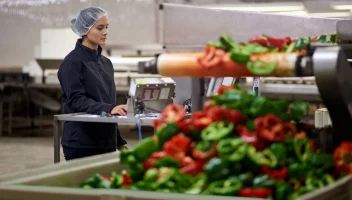En vedette dans cet article
Supporting a Circular Economy in the Food and Beverage Industry
Supporting a Circular Economy in the Food and Beverage Industry
2 Oct 2024
John McCurdy
As the push for greater sustainability in the food and beverage industry grows stronger, governments around the world are publishing more concrete and specific guidance with regards to how progress can be achieved. One concept model gaining traction as a result is that of a circular economy, a system devised to reduce waste and make better use of resources by mimicking natural regenerative cycles.
The European Union led the charge on this front, passing its Circular Economy Action Plan (CEAP, commonly referred to as “Closing the Loop”) with both legislative and non-legislative measures in 2015. Having implemented all 54 of the actions of the plan by 2019 and continuing to see improvement across several key metrics, the EU has now updated the CEAP and is carrying it forward with the European Green Deal, which aims to reduce greenhouse gas emissions by at least 55% by 2030.
In the U.S., the National Strategy for Reducing Food Loss and Waste and Recycling Organics was released by the White House, Environmental Protection Agency, Department of Agriculture and Food and Drug Administration in 2024. One of several programs aimed at building a circular economy—and the most relevant of them for the food and beverage industry—its objectives include preventing food waste and loss; increasing the recycling rate; and enforcing (or incentivizing) those practices for businesses.
Knowing that the food and beverage industry is one of the largest contributors to global greenhouse gas emissions (accounting for 37% annually) and that roughly one-third of all food around the world goes uneaten, it’s clear that our existing models of agriculture and manufacturing must continue to become more sustainable. And that can’t be accomplished by reducing waste alone—valuable byproducts and materials left over from processing and production must also be repurposed as raw inputs for other products.
But before we explore the core components of a circular food and beverage economy further, let’s first come to understand why the current linear one is as flawed and wasteful as it is.
Why the Linear Food and Beverage Economy Must Change
The existing linear economic model followed by most food and beverage businesses centers on using finite resources and the most efficient production methods to create products. Those products then offer value one time (in consumption) or not at all (in the case of waste, whether through spoilage, damage or simply being discarded uneaten).
The negative consequences of this system, developed to benefit productivity even at the expense of other important considerations, are evident from the beginning of the supply chain. At the farm level, intensive agricultural practices lead to 39 million hectares of soil being degraded each year while accounting for 70% of freshwater consumption worldwide.
The linear economy is also very expensive to maintain, with half of the roughly $12 trillion USD that goes into global food and beverage production being attributed to the way the products are made—that is, the methods themselves, not the raw inputs, workforce hours or any of the other resources required.
What’s more, strategies frequently adopted as a result of the focus on efficiency—like overuse of fertilizer and pesticides; fossil fuel consumption for energy; and reliance on antibiotics for livestock—have serious consequences for human health. From dangerous illnesses contracted through incidental chemical consumption to lung conditions caused by air pollution and increased microbial resistance, people around the world pay the price.
Three Core Components of a Circular Food and Beverage Economy
While legislative reform can bring about sweeping change and relatively small acts can make a big difference in terms of sustainability, creating a circular economy is neither an overnight process nor a one-dimensional effort. There are three key components that make up the food and beverage industry-specific version of this model.
1. Source Foods Grown Regeneratively
If it’s to be accomplished, establishing a circular economy in the food and beverage industry will start at the beginning of the supply chain, which in most instances is the farms that produce the raw inputs used to create finished products. It’s there that methodologies falling under the wider umbrella of regenerative agriculture—defined as a conservation and rehabilitation approach to food and farming—must be embraced.
While your business may or may not be engaged in farming explicitly, you can choose to source your raw materials from farms that espouse regenerative agriculture ideas. So whether or not you’re growing your own crops, you should understand and value these practices:
Organic fertilizer use – Using organic matter as fertilizer avoids the introduction of chemicals into soil and water, and it is both cheaper and more sustainable to source.
Crop diversity and rotation – Planting different crops in the same area across a sequence of seasons allows farming operations to better protect their harvests from pests and weeds, alleviating at least some need for pesticides and herbicides.
Animal integration and rotational grazing – Introducing livestock alongside crops and pasturing them in different planting areas across a sequence of seasons improves soil quality while also helping to keep the animals healthy.
Crop covering – Planting cover crops (those not intended for human consumption) during off-seasons is critical in preserving soil quality, as they keep the soil aerated and help prevent erosion.
Composting – Collecting both leafy and woody organic waste and allowing it to decompose provides a source of nutrient-rich fertilizer in which beneficial organisms like bacteria and fungi can grow.
Agroforestry – Introducing trees alongside crops helps to prevent soil erosion, aids in carbon sequestration and contributes to biodiversity.
Soil preservation – Minimizing the disturbance of soil, through crop covering but also no-till and reduced-till techniques, helps to prevent erosion and improves the retention of both water and nutrients.
This is by no means a complete list, but it encompasses a variety of methods that farms can use to be more environmentally friendly and contribute to a circular economy.
2. Reduce Waste in Manufacturing and Related Activities
To put the shocking statistic on food waste cited above into more concrete terms, that one-third of all food that goes discarded amounts to a staggering 1.3 billion tons of food fit for human consumption ending up in landfills around the world, where it rots and emits harmful greenhouse gases.
Some of that is attributable to consumption habits, especially in more economically developed areas where food is plentiful, oversize portions are common and food simply isn’t valued as highly as it is in less developed regions. But much of the waste occurs at the manufacturer level, where it can be at least partially addressed with the following:
Expiration date management – Tracking expiration dates of both raw materials and finished products—and using that information to implement first expiry, first out (FEFO) picking practices—helps minimize waste due to spoilage.
Environmental controls – Maintaining proper temperature and humidity in areas where perishables are stored (including during transportation) is necessary for preserving many ingredients and products.
Sanitation and allergen segregation – Adhering to rigorous sanitation and allergen segregation protocols can prevent contaminations that could result in entire batches of finished goods being discarded due to food safety concerns.
Equipment calibration – Ensuring that your manufacturing equipment—including fillers, mixers, ovens, conveyor lines and more—are calibrated correctly assists in minimizing food waste from overfill, overcooking and equipment malfunctions.
Employee training – Providing proper training for staff enables them to manage ingredients and products safely during transport, storage, production and order fulfillment, curbing waste from mishandling.
Alternative and reduced packaging – Using biodegradable materials for your product packaging and reducing the total amount of material used in your packaging help to reduce yet another source of potential waste.
Again, this is just a selection of practices that can be used to reduce waste creation that occurs as a result of your business operations. Scrutinizing your unique processes may reveal additional opportunities.
3. Leverage the Full Value of Byproducts
As time goes by, food scientists and product developers are discovering (or creating) more and more methods for repurposing food and beverage manufacturing byproducts. In the past, these materials would have been disposed of without any of their value being extracted, so these are exciting ways that businesses can “turn trash to treasure.”
While not all of the products that can be made from byproducts are edible, they are all in demand. Keep in mind that if your business is not in the position to purchase new equipment and/or devote additional workforce hours to repurposing byproducts, it’s likely that another company that specializes in the practice would consider purchasing your useful byproducts. They could be used to create one of the following:
Biofuel and biogas – Through anaerobic digestion made possible by the work of bacteria on food waste in a sealed vessel absent of oxygen, various liquid biofuels and renewable natural gases can be produced for use as an energy source.
Beverage ingredients – Leftover grain and other bakery byproducts can be used in fermentation to produce alcoholic beverages like beer and liquor, while fruit peels, overripe produce and “ugly” produce are potential inputs for juices and teas.
Fertilizer – Much like the leafy and woody waste that occurs at the farm level can be composted and turned into fertilizer, so too can many organic food and beverage byproducts when allowed to decompose.
Processed food ingredients – Many companies have developed processes to utilize spent grains from alcohol fermentation for baking and snack manufacturing, and fruit and vegetable byproducts (including overripe and ugly produce) can be used in prepared foods and flavorings.
Proteins and oils – Superfiltration, a process conducted using purpose-made membranes, can separate proteins and oils from a variety of food and beverage waste streams.
There are many possibilities on this front, some of which have yet to be explored. Depending upon the segment in which your business operates, you may find that what you’re throwing out could actually be making you money.
Solutions That Support Circular Economy Practices
Considering that our current economic system and the businesses operating within it—including yours—were built with the intent of maximizing efficiency and profitability, with minimal concern for environment, it’s likely that your company will need some new tools to implement sustainable and circular economy practices. Ideally, they’d come in the form of industry-tailored software solutions that support your organization’s digital transformation.
For example, a food enterprise resource planning (ERP) system with supplier management functionalities can help you on-board suppliers who produce their goods using regenerative agriculture practices. The same solution can also provide expiration date management, allergen segregation and packaging functionalities to facilitate your efforts on those fronts.
Meanwhile, overall equipment effectiveness (OEE) software can allow you to track manufacturing performance in real time, including losses that could be occurring due to equipment malfunctions or gaps in employee training. Equipment asset management (EAM) systems takes this a step further, helping you implement preventive maintenance plans and procedures to boost asset uptime and equipment lifespans.
And when it comes to creating new food and beverage offerings from byproducts, an industry-specific product lifecycle management (PLM) solution can facilitate the ideation and formulation processes with specialized modules. What's more, PLM can standardize the new item’s manufacturing process while also offering functionalities for packaging and label design.
So whether your food and beverage business is implementing circular economy practices to comply with government mandates or simply to appeal to more conscious consumers, you shouldn’t discount the difference that purpose-built systems can make. Nor should you discount what it means to have a single, trusted provider for all of your software needs.
Here at Aptean, we’re proud to serve each customer as a long-term partner, helping to ensure that they realize a maximum return on investment and significant process improvements. Our comprehensive suite of food and beverage software is cloud-ready and seamlessly integrated, allowing your business to implement without additional hardware and scale your tech stack as necessary.
Lastly, our award-winning ERP includes unique, advanced capabilities[AM3] built on the robust Microsoft Dynamics 365 Business Central platform—so you get the value of specialized features while benefiting from a familiar interface and can leverage the expert support of our dedicated in-house teams.
Want to learn more about Aptean’s portfolio of solutions designed for the challenges that food and beverage businesses face? Contact us, request a free demo, or inquire about pricing today.
Related Content





Prêt à transformer votre entreprise ?
Nous avons les solutions ERP spécialisées dont vous avez besoin pour relever les défis de votre secteur.



